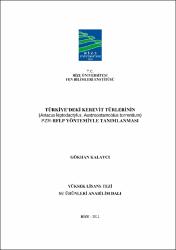Türkiye'deki kerevit türlerinin (Astacus leptodactylus, Austropotamobius torrentium) PZR-RFLP yöntemiyle tanımlanması
Abstract
Kerevitler dünyanın birçok bölgesinde ve ülkemizde dağılım gösteren yüksek derecede ekonomik, ticari ve ekolojik öneme sahip omurgasız hayvanlardır. Türkiye'de Astacus leptodactylus Eschscholtz, 1823 (Türk kereviti) ve Austropotamobius torrentium Nordmann, 1842 (Taş kereviti) olmak üzere iki tür kerevit dağılım göstermektedir. Astacus leptodactylus'un ülkemizde iki alt türe sahip olduğu bildirilmiş olup (Astacus leptodactylus leptodactylus, Astacus leptodactylus salinus) Anadolu'daki birçok iç su kaynağında doğal olarak yayılım gösteren tek tür olma özelliğine sahiptir. Austropotamobius torrentium ise ülkemizin doğal olmayan tek kerevit türü olup ilk kez 2005 yılında Kırklareli sınırları içindeki Velika Deresinden, 2007 yılında da Madara Çayından kayıt verilmiştir.Mevcut türler ve alt türlerin faklılıklarını ortaya koymak için yapılan çalışmalar, sadece diagnostik veya biyo-ekolojik karakterlere dayanmakta olup alt türlerin varlığı, dağılım alanı ve diğer türden ayrılması hususunda kesin ve net bir yargıya varılmasını güçleştirmiştir. Bu nedenle tür içi veya türler arası bölgesel farklılıkları veya benzerlikleri ortaya koymak amacıyla yapılan çalışmaların genetik çalışmalarla mutlaka desteklenmesi gerekmektedir.Türlerin tanımlanmasında moleküler belirteç kullanılarak farklılığın ortaya çıkarılması amacıyla, türler ve alt türleri temsil edecek şekilde seçilen istasyonlardan örneklemeler yapılmıştır. Türlerin genetik olarak tanımlanmasında yaygın olarak kullanılan moleküler belirteçlerden biri olan PZR-RFLP tekniği uygulanmıştır. On sekiz adet kesim enzimi kullanılmış olup bunlardan hiçbiri Astacus leptodactylus türünde tanıma bulamamıştır. Üç kesim enzimi ise Austropotamobius torrentium türünde kesim bölgesi bulmuştur ve iki bant vermiştir.Bu çalışma ülkemizde dağılım gösteren kerevit türlerinin ve tartışmalı olan alt türlerinin DNA'ya dayalı moleküler belirteçler kullanılarak tanımlanmasına yönelik yapılan ilk çalışmadır. Çalışmada seçilen PZR-RFLP tekniği türleri başarılı şekilde ayırmış olmasına rağmen alttürler arasında varyasyon belirlenememiştir. Crayfish shows distribution in many parts of the world and our country is the invertebrate animals that has an economic, commercial and ecological importance . In Turkey it has two species, which are Astacus leptodactylus Eschscholtz, 1823 and Austropotamobius torrentium Nordmann, 1842. Two sub-species have been reported for Astacus leptodactylus (Astacus leptodactylus leptodactylus, Astacus leptodactylus salinus) and also in Anatolia, it has a qualifity that only species in the source of many inland water as a natural distribution. Austropotamobius torrentium is the only species that not natural for inland waters in Turkey and first time recorded 2005 within the boundries of Kırklareli Velika brook, and Madara creek in 2007.The studies carried out showing the differences between current species and sub-species based on only diagnostic or bio-ecological characters and were hampered for regarding definite and clear judgement presence of sub-species, distribution area and separating from other species. For this reason, studies that purpose bring out regional differences or similarities between intra-or inter-species have to be supported by genetic studies.In order to identify the species and subspecies by using molecular markers, sampling stations were selected to represent the species and subspecies. PCR-RFLP technique which is commonly used the molecular markers for genetic identification of species was used. Eighteen restriction endonucleases was used, none of these find recognization site for A.leptodactylus. Three restriction endonucleases have found a recognization site and gave two fragments for A. torrentium.This is the first on identification of crayfish species and it?s controversial subspecies based on DNA markers Although PCR-RFLP technique used in this study differantiated the species sucsesfully, variation was not found between subspecies.
Collections
- Fen Bilimleri Enstitüsü [340]


















